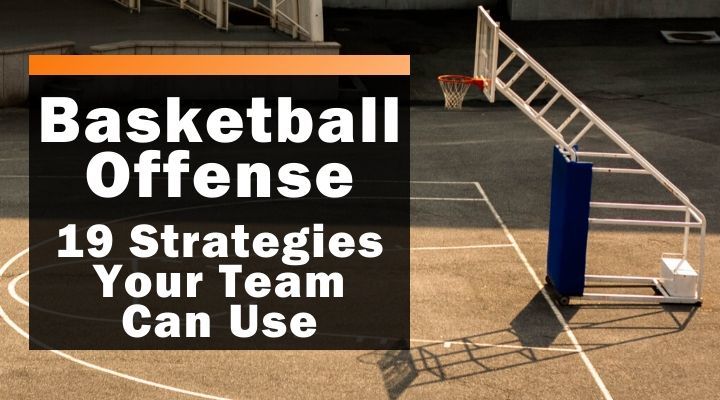
Coaches frequently repeat the old adage, “Defense Wins Championships”.
And while there is a lot of truth to that, we all must remember that your team needs to put points on the scoreboard to stand any chance of winning.
As coaches, it’s our job to put our team in a good position to score.
That’s where your basketball offense comes in.
One of the coolest things about offense is there is no “right” way to do it.
There are many offenses to pick from, and successful coaches at all levels have utilized a variety of styles to score points and win championships.
But which offense should YOU use?
That’s a complicated question.
It’s our hope that this guide will help to clarify your options and assist you in choosing a basketball offense that helps your team succeed.
Here’s the first step...

4 Important Factors to Consider
There are several important things to think about before choosing an offense:
1. Your Team’s Age and Skill Level
This is a huge consideration.
An appropriate offense for a youth team will often be completely different than an appropriate offense for a college team.
Consider which offense suits the goals of your level of play.
Also, it’s important to remember that some offenses take longer than others to learn.
If you coach a youth team and only get one 30-minute practice each week, you probably don’t have time to implement anything advanced like the full Triangle Offense.
While high school and college teams with more available practice time do have this option.
2. Your Coaching Philosophy
Coaches should only implement an offense that fits with their “philosophy”.
Choose something you know and believe in.
Do you want to give players maximum freedom, or do you want to control more of the action?
Do you want to play as fast as possible, or do you want to slow down and control the clock?
Do you want to attack through the post, or would you rather rely on the three?
None of these options are inherently right or wrong, but you must know who you are as a coach.
The better an offense fits with your overall philosophy, the better you will teach it and the more you will believe in it.
3. Your Team’s Personnel
This one is crucial.
An offense may look great on paper, or you may love watching your favorite college team run it.
But will it work for YOUR team?
Consider the strengths and weaknesses of your players.
Do you have great shooters, or do you play better out of the post?
Do you have the skill to break defenders down off the dribble, or do your players need screens to create an advantage?
What offense will ensure your best players get the ball in their favorite spots?
Asking yourself these questions can help ensure you choose a basketball offense that best fits your personnel.
4. Your Defensive Philosophy
This one is often overlooked.
Ideally, a team’s offensive and defensive philosophies will fit together.
For example, a team that presses and traps to speed up the pace probably doesn’t want to use a slow-down style of offense.
A great example of connection between offense and defense is Virginia, led by Tony Bennett.
On defense, they play a pack line style, seeking to grind out half court stops...
And then on offense they control the ball and make their opponent work, utilizing the mover-blocker motion offense (more on this later).
This is effective because Virginia knows who they are and both sides of the ball fit together.
Basketball Offense: 19 Strategies
While there are countless offenses to choose from, most can be broken into one of the following categories:
These next sections will explain the differences between these categories and give you some examples of offenses that fit each description.
1. Motion Offense
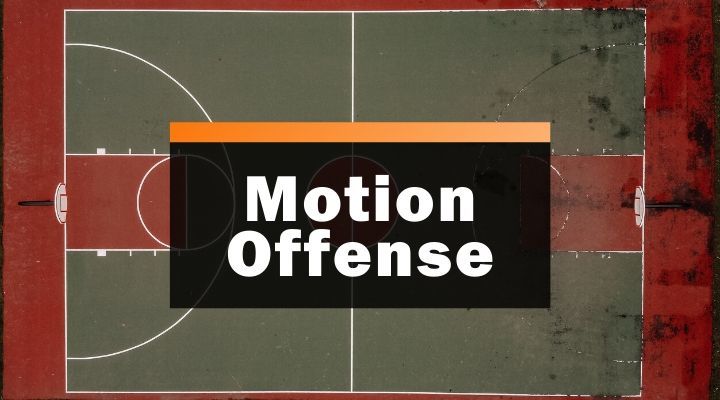
Motion offense is characterized by player decision-making rather than memorization.
In a motion offense, coaches teach several different concepts to the team and then give players opportunities to read the defense and make their own decisions.
Pros of Motion Offense:
Great for Teaching the Game - Motion offense teaches players HOW to play, rather than asking them to remember plays. Because of this, it helps players think throughout the game and make decisions. This can be highly beneficial for the long-term development of a player.
Difficult to Scout - Because motion offense relies on making reads, it can be difficult to scout. Michael Jordan said, “The defense is always wrong.” When a team masters motion offense, it will automatically make reads that attack whatever the defense is doing.
Will Get Better With Time - Learning motion offense is a process. When players master the basic aspects, the coach can add higher-level layers. As players get more comfortable with the reads and additional layers are added, this offense will become very difficult to defend.
Equal Opportunity - In most motion offenses, all five players get consistent touches and shots. The ball is supposed to find the open player. Motion is great for balanced teams and for developing all players.
Cons of Motion Offense:
Reads Are Difficult for Young Players - Despite its many benefits, motion offense is not easy. Some players prefer being told where to go and what to do, but a true motion offense does not give them this structure. It can take a while for players to learn to read the defense.
Can Be Ugly at First - Along those same lines, coaches who want to install a motion offense must be patient, especially at younger levels. This is not a system that will be mastered in a week. However, some patience early on can pay dividends down the road.
Best Players May Not Take the Most Shots - One potential problem with motion offense is that it is not necessarily geared to a team’s best players. Because it’s equal opportunity, sometimes weaker players may take equal or more shots than the team’s starts unless the coach does a good job of role definition.
Examples of Motion Offenses:
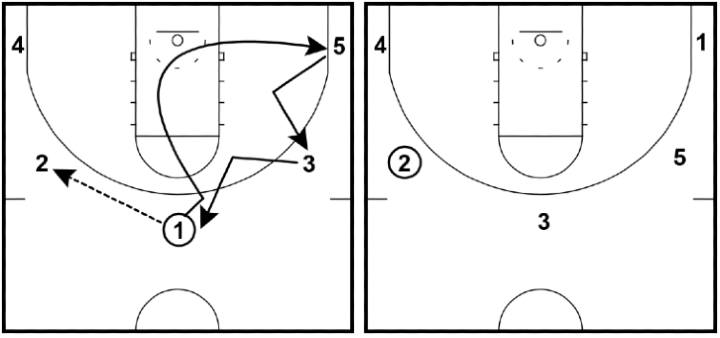
5-Out Motion is what most people first think of when they think motion offense.
The name “5-Out” refers to the fact that all five players are stationed outside the 3-point line.
This opens up the middle of the floor for cutting and driving opportunities.
Most of the time, 5-Out coaches instruct their players to immediately cut or screen after passing to a teammate. Screen options typically include down screens, flare screens, and ball screens.
Reasons to Consider 5-Out Motion:
- Spreads the floor.
- Everyone gets touches, cutting, and driving opportunities.
- Makes the defense defend movement.
Learn more about the 5-Out Motion Offense here.
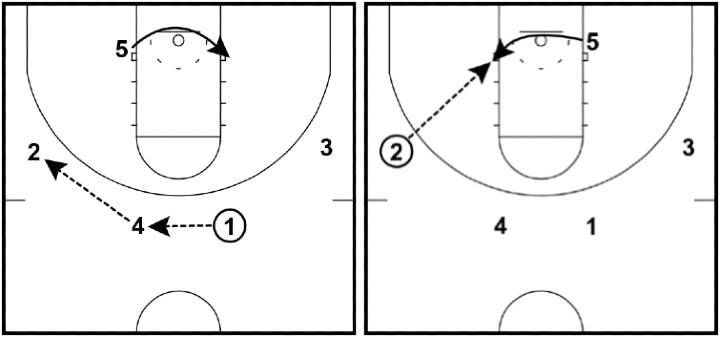
This is arguably the most common motion offense used in the modern game.
4-out motion teams play four players on the perimeter and one player in the post, and styles of the 4-out vary considerably depending on how the coach uses their post player.
Examples:
If you have a skilled post player, keep them on the ball-side looking for post entries.
If you have a clumsy post player, station them on the weak-side and open the floor for driving and cutting opportunities for the other players on the floor.
Perimeter players have a number of options in this offense – basket cut, down screen, flare screen, etc.
Reasons to Consider 4-Out Motion:
- Allows you to use a good post player.
- Bigger perimeter driving gaps.
- Allows for many screening opportunities.
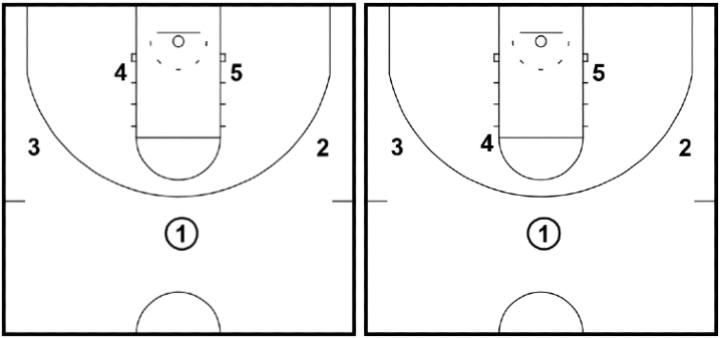
Another type of motion offense is the 3-out, 2-in offense, and it’s a great offense for big teams with more than one highly skilled post player.
Three guards play on the perimeter, while the two posts play on the blocks or in the high post.
In most versions of 3-Out Motion, the post players cross screen for one another, then flash to the ball.
If you are considering this basketball offense, please note that the spacing does jam up the middle of the floor, making it hard to drive the ball.
It may not be the best basketball offense to maximize a talented perimeter player.
However, coaches can get creative and incorporate ball screens or back screens into this offense to add options for guards as well.
Reasons to Consider 3-Out Motion:
- Allows you to maximize good post players.
- Post catches often lead to free throw attempts.
- Offense creates inside/outside passes for jump shots.
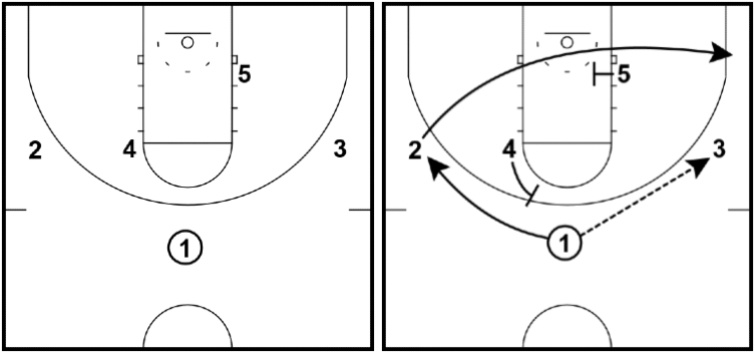
This is a beautiful form of motion that splits players into one of two roles:
- Blockers
- Movers
There will typically be two blockers who look to set screens for the three movers.
This offense gives players a great deal of freedom, as there are no scripted movements. Because of this freedom, a variety of screens can be used – back screens, pin screens, flare screens, ball screens, etc.
While the offense is usually geared to creating shots for the movers, the blockers frequently break open after screening.
As with motion offense in general, Mover-Blocker takes some time to develop, as players must learn how to read the defense effectively.
Reasons to Consider Mover-Blocker Offense:
- Forces the defense to guard movement.
- Lets the coach determine roles for each player.
- Utilizes perimeter and post options.
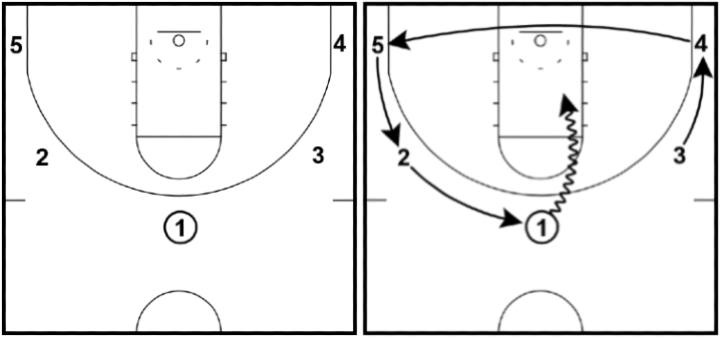
The Read and React is a versatile motion offense created by Rick Torbett.
It can be run out of the various motion alignments: 5-out, 4-out, or 3-out.
What makes this offense unique is that it is taught in layers. Once players master one layer, another can be added.
For example, the first layer is a simple pass and cut. When your team can effectively pass and cut, they can progress to the second layer, dribble penetration.
Coaches can choose the layers that best fit their teams, so it’s possible to progress and adjust year-to-year.
Reasons to Consider Read and React Offense:
- Its versatility makes it a great “program” offense.
- It can be run from different alignments.
- Coaches can choose the actions that best fit their personnel.
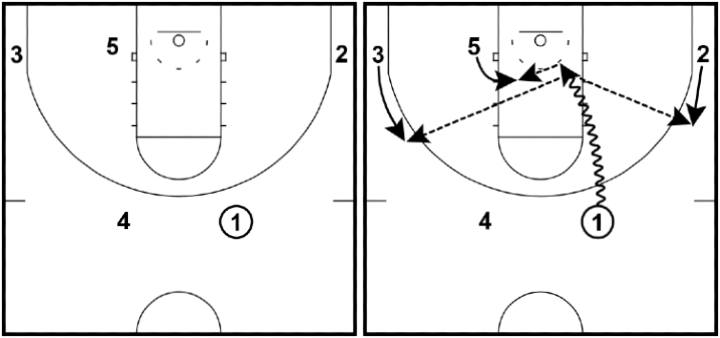
Dribble-Drive Motion is a popular offense created by Vance Walberg.
This offense is typically run out of a 4-out alignment with the post player opposite the ball.
The focus of the offense is letting players beat their defender off the dribble.
A key to running this offense effectively is teaching players how to react to their teammate’s penetration. When help comes, the driver must make the correct decision.
The post player may not get a lot touches in this offense, but he or she should be the recipient of drop-off passes and put-back rebounds for easy layups.
Reasons to Consider Dribble-Drive Motion Offense:
- It instills an “attack” mentality in players.
- Very effective for guard-heavy teams with good drivers and shooters.
- Teaches players to play with and without the ball.
2. Continuity Offense
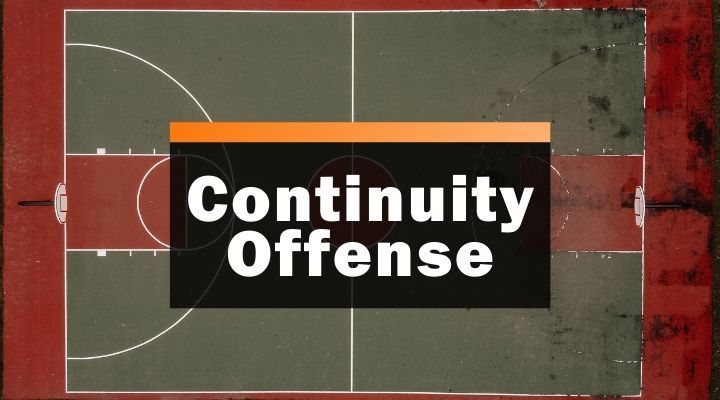
A second option is running a continuity offense, which is much more structured than a pure motion offense.
Players are asked to execute patterns of actions that eventually lead them back to the starting formation.
A series of cuts or screens will happen on one side of the floor, then the offense will reset and start over on the other side of the floor.
Pros of Continuity Offense:
Difficult to Guard - Continuity offenses allow coaches to script consecutive actions that can be difficult for a defense to guard. Most continuities rely on a number of screens, which can result in easy baskets for the offense.
Easy to Learn - Because continuities are patterned, they can be easy to learn. Players can memorize positions on the floor and the series of actions. Some continuities can be learned in just a few practices.
Cons of Continuity Offense:
Easier to Scout and Disrupt - A drawback of continuity offenses is that a smart coach can sometimes teach defenders to disrupt the offense’s pattern. If the offense relies on a wing entry, the defense could deny the wing or trap the ball-handler. For a continuity to be effective, it must have built-in counters for these situations.
Can Cause Players to Become “Robotic” - Because continuities tell players where to go and what to do, they can lead to “robotic” players. Inexperienced players sometimes get so caught up in running the pattern, that they miss out on opportunities to score. Coaches using continuity offenses must find a balance between execution and freedom.
Examples of Continuity Offenses:
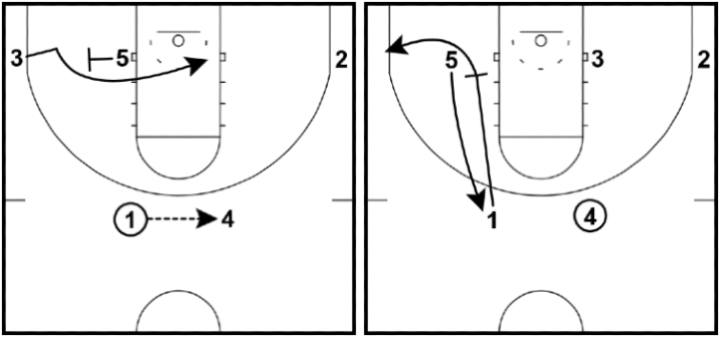
The Flex Offense has stood the test of time and is still effective in today’s game.
It is a positionless offense, where players rotate through all five positions on the floor.
While it can be initiated multiple ways, the basis of the flex is a baseline cross screen, followed by a down screen for the screener.
This “screen the screener” action is difficult to guard because it forces the defense to make tough decisions while navigating multiple screens.
Reasons to Consider the Flex Offense:
- It lets all players play inside and outside.
- It creates opportunities for layups and post-ups.
- Shooters can get open by setting and using screens effectively.
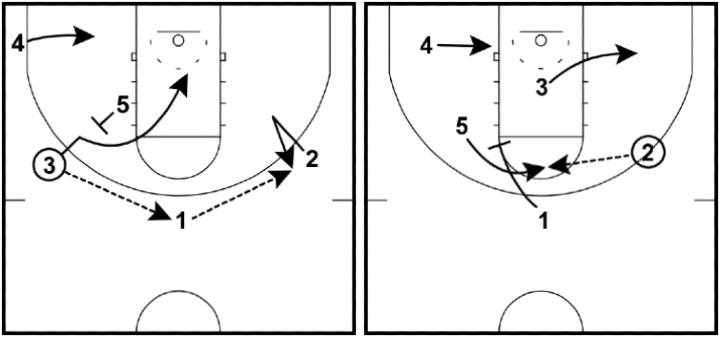
The Shuffle Offense is very similar to the Flex because it also utilizes the “screen the screener” concept.
The primary difference between the Shuffle and the Flex is the position of the screens.
While a flex screen is set on the baseline, a shuffle screen is set near the elbow, curling a cutter to the rim. The screener then receives a down screen and cuts to the top of the key.
The action repeats on the other side of the floor.
Reasons to Consider the Shuffle Offense:
- All players can play inside and outside.
- It doesn’t rely on great ball-handling.
- Screen the screener action is inherently tough to guard.
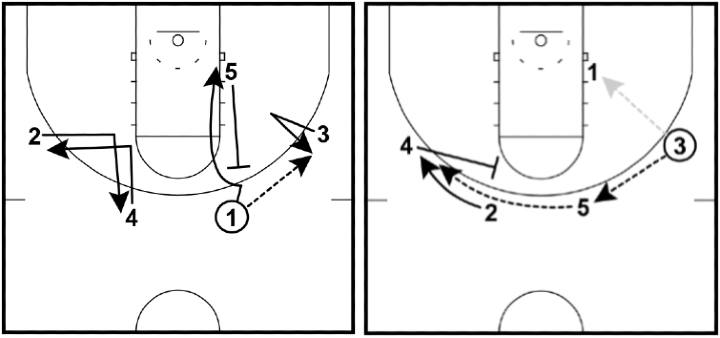
The Swing Offense is another continuity that emphasizes getting the ball into the post.
This offense runs from a 4-out alignment and utilizes UCLA cuts, flex cuts, flare screens, and down screens to free up players for great shots.
This is a patient offense that seeks to attack the defense on the second or third side of the floor.
Reasons to Consider the Swing Offense:
- Big guards excel because they can post-up smaller opponents.
- It has many options for inside and outside shots.
- It makes the defense guard multiple actions.
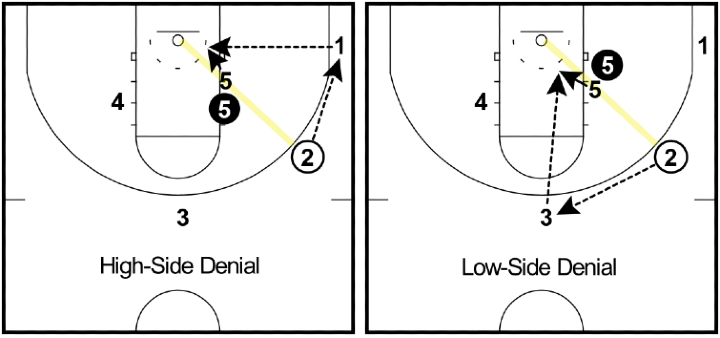
The Triangle Offense has gained fame from the success of Phil Jackson and Tex Winter’s Chicago Bulls and Los Angeles Lakers teams, but the offense can be very successful at the high school level as well.
The offense is built around post play, isolations, ballscreens, and post splits, relying on high basketball IQ and players being unselfish.
It gets its name from the triangles formed with the post and perimeter players.
Reasons to Consider the Triangle Offense:
- All players are involved in the offense.
- It develops basketball IQ.
- It has built-in pressure release options.
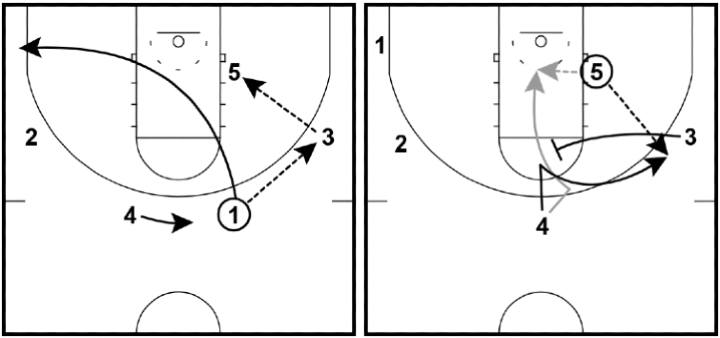
The Princeton Offense is another basketball offense that can be extremely successful if you have a high-IQ team.
This offense utilizes a skilled post player, who must be a good passer and decision-maker.
Princeton is famous for its backdoor cuts, made famous by Pete Carril’s college teams, but it includes multiple actions.
“Princeton” is actually a blanket term for three separate options used by Carril – Low Post Series, Point Series, and Chin Series.
Chin, using backscreens and dribble handoffs to create good shots, is particularly popular.
Reasons to Consider the Princeton Offense:
- Builds basketball IQ.
- Doesn’t require much size or a dominant inside presence.
- Promotes passing and unselfishness.
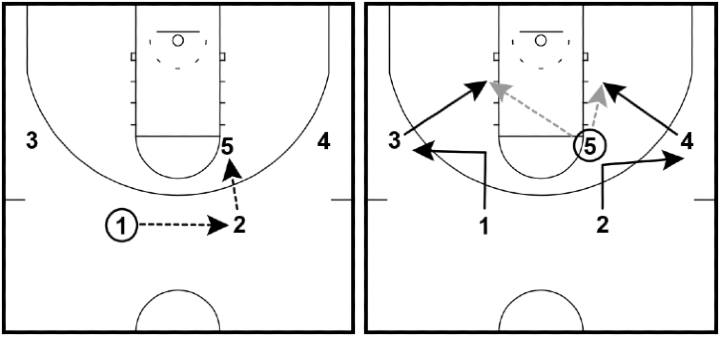
This offense was made famous by legendary UCLA coach John Wooden.
It is run out of a 2-3 alignment with someone in the high post.
One central action is now known as the “UCLA cut” – a back-screen from the high post.
Because all players play above the foul line, baseline drives are available and a team does not need to rely on a strong post player.
Reasons to Consider the UCLA Offense:
- There are options for perimeter and post players.
- Includes a variety of difficult-to-guard actions.
- Lends itself to a number of quick hitter options.
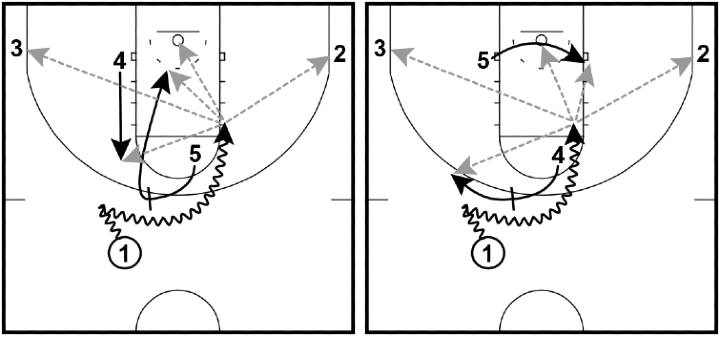
The pick and roll is the most commonly-used action in today’s game.
It can be used as a motion or continuity offense.
A pick and roll occurs when one offensive player screens the defender of a teammate with the ball. This can create indecision in the defense, leading to an offensive advantage.
Pick and rolls can be set anywhere on the floor, and when executed properly, this action is extremely difficult to guard.
If two defenders attack the ball-handler, the roller is open for a layup.
If the defense doesn’t stop the ball, the ball-handler is free.
If the defense collapses on either player, their teammates are open for kickout passes.
Reasons to Consider Pick and Roll Offense:
- Forces the defense to make difficult decisions.
- Lets good guards make plays with the ball.
- Can create mismatches when defenses switch.
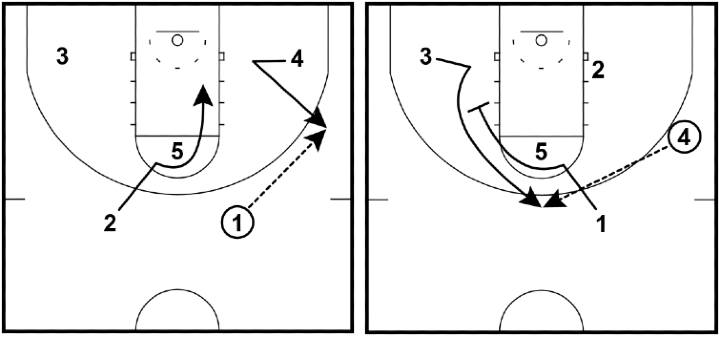
This is a classic basketball offense that has been used effectively for years.
The Wheel is similar to Flex and Shuffle.
It involves three main actions: a high post screen, a down screen, and a flex screen. Because of all of this movement, it can be very difficult to guard.
It can, however, lead to some robotic play because it is a lot for young players to remember.
Reasons to Consider the Wheel Offense:
- Includes a number of screening options.
- Allows you to control the ball and run the clock.
- Doesn’t rely on a great post player.
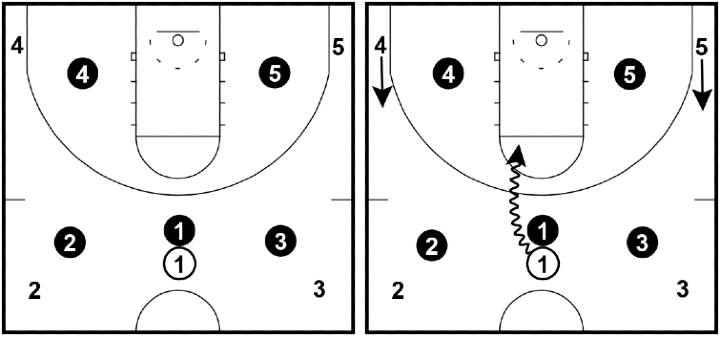
This is an offense popularized by Dean Smith at North Carolina.
It’s typically used as a delay offense to run down the clock late in a game.
However, there are many opportunities to score out of the Four Corners as well.
A quick guard plays in the middle of the floor with the other four players spread to the corners of the court. This allows for maximum spacing and makes it difficult for a defense to help or trap.
If the ball-handler breaks down his or her defender, they can score or kick the ball out.
If a great shot isn’t created, players will remain spaced and the offense will reset.
Reasons to Consider the Four Corners Offense:
- Can effectively run down the clock when your team is winning.
- Provides space for a talented guard.
- Can force defenses to play man rather than sitting in a zone.
3. Set Play Offense
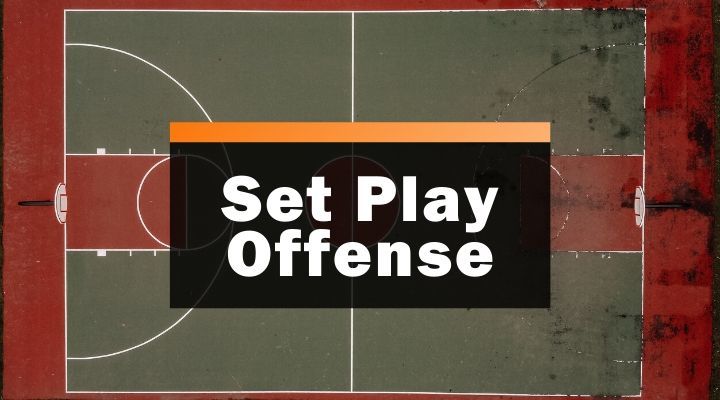
Set plays are specific plays designed to get certain players the ball in certain areas of the floor.
Unlike motion, sets clearly specify the actions the coach wants, and unlike continuities, sets don’t repeat over and over.
Most set plays seek to run a quick, difficult-to-guard action to get the ball to a good player.
There are many set plays available online, so coaches should choose or create the ones that best fit their team.
Pros of Set Plays:
Coaches Control Shot Selection - The biggest positive of set plays is that they ensure the best players will be in position to get quality shots. Coaches can design actions that feature a quality post player or a great shooter.
Difficult to Guard - Creative coaches can draw up actions that put the defense in tough situations. Set plays can be very effective late in close games when a quick basket is needed.
Cons of Set Plays:
Hard to Remember - Unlike a motion or continuity offense, a single set play can’t be an offense by itself. Coaches who rely on sets may run 5-10 or even more. This can be hard to remember, particularly for younger players.
Can’t be Overused - The defense will adjust to even the best set plays if they are used too frequently. It is important to mix-up your sets and to build in counters to your go-to actions.
Not Great for Player Development - Sets often keep the ball in the hands of your top few players. While this can be good at times, it does not lend itself well to player development. Some players may feel uninvolved in the offense if they don’t get consistent touches or shots.
Examples of Set Plays:
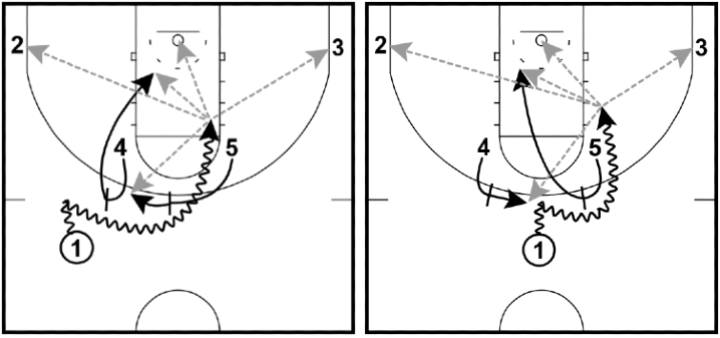
As previously stated, there are thousands of set plays at your disposal.
If you turn on an NCAA, NBA, or WNBA game, you are likely to see several sets out of a “Horns” alignment.
This means a 1-2-2 set with a point guard at the top of the key, post players on each elbow, and wings in each corner. Many actions can begin from this alignment.
Most horns plays involve a ball-screen or an entry to one of the post players on an elbow. From here, coaches can use their creativity to incorporate any types of screens or cuts they want.
Reasons to Consider the Horns Set Play Offense:
- Many actions can be used to create shots for your best players.
- Spacing makes it difficult for the defense to help.
- You can keep the ball in the hands of your most skilled players.
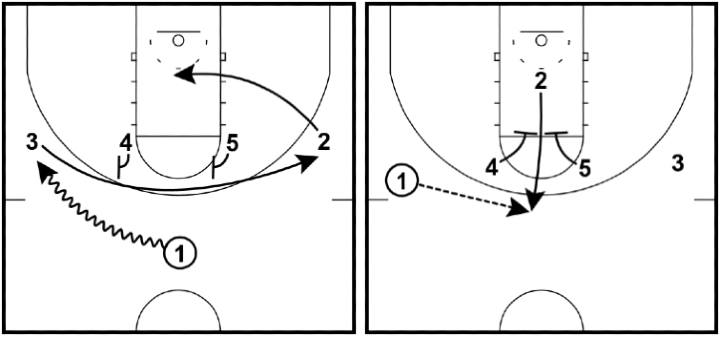
Another option you have is to browse through the thousands of different basketball plays posted online and create your own personal playbook.
You can choose set plays that start in a box formation, a 1-4 high formation, 1-2-2 formation (like horns), or any other variation you can think of.
Pick 3 - 5 of them and use those as the foundation of your offense.
One word of warning if you take this approach:
If you choose many different starting formations, teams can quickly learn which set play you’re going to use depending on how the team sets up.
Reasons to Consider Choose-Your-Own-Plays Offense:
- Can choose plays that set up your best players.
- Option to start from a wide range of formations.
- Maximum flexibility.
4. Zone Offense
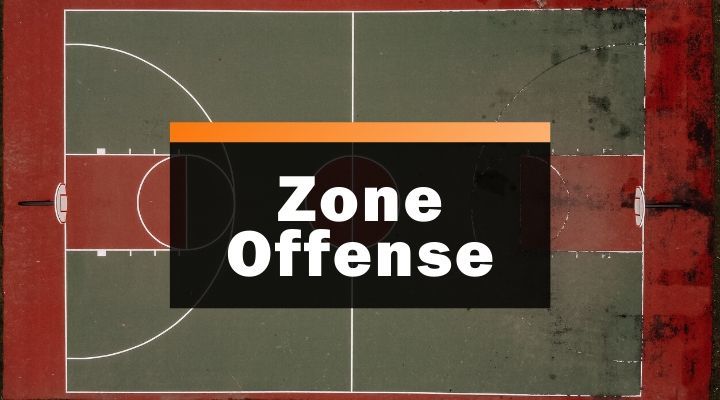
Regardless of your offensive selection, if you run it well enough, you may see an increasing number of zone defenses.
While some man-to-man offenses can also be used against zones, most coaches instead turn to a separate zone attack.
There are many quality zone offenses out there, but here are a few examples.
Examples of Zone Offense:
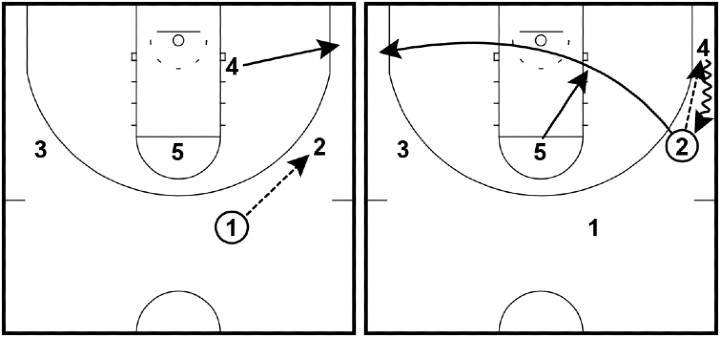
This is a zone offense that utilizes dive cuts and “drag dribbles” to manipulate the zone.
By initially overloading a side, the Milton Zone Attack forces zone defenders to make difficult decisions.
Unlike many zone offenses, it is not a stagnant attack. Instead, it makes the zone defend player movement as well as ball movement.
Reasons to Consider the Milton Zone Attack:
- Overloads are difficult for zones to defend.
- Various wrinkles that can be added to this zone offense.
- Can create 1 on 1 opportunities on the block.
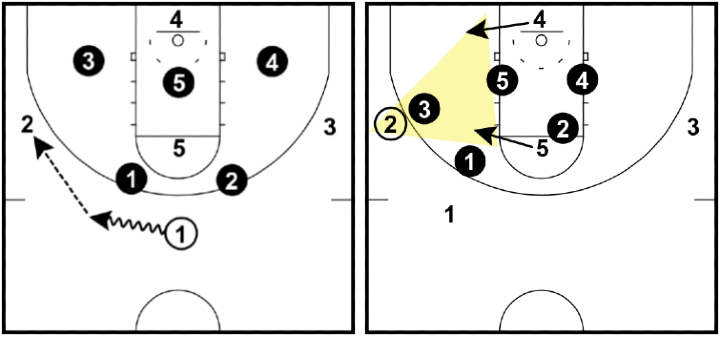
The 1-3-1 Zone Offense is very effective against 2-3 zones.
This offense creates indecision because wing players play in the gaps between the top and back lines of the defense.
Teams using this attack will utilize the high post and short corner, two inherent weak areas of 2-3 zones.
This offense is a good fit for youth, middle school, or high school teams.
Reasons to Consider the 1-3-1 Zone Offense:
- The high post and short corner areas are difficult for zones to guard.
- Allows for inside and outside opportunities.
- Simple to teach.
The Best Youth Basketball Offense
As you can see, coaches have MANY options when choosing an offense.
However, if you coach at the youth level, you probably have players who are only just starting to learn the game of basketball and limited practice time.
Because of this, we recommend using a simple motion offense for youth teams.
5-Out Motion is the perfect fit because of its positionless nature.
At the youth level, it is best to avoid labeling players as specific positions, and the 5-out is great for development because it allows everyone to handle the ball, cut, pass, screen, and shoot.
Three simple rules can create an effective 5-Out offense at the youth level:
- Cut to the basket after every pass.
- Fill to the ball when there is an open spot.
- Back cut when the defense denies you.
If a young team can learn those simple rules, its players will score plenty of points, and, more importantly, will enhance their basketball IQ.
When the team is ready, coaches have the option of incorporating off-ball screens, ball screens, post play, and much more.
Conclusion
Choosing a basketball offense that fits the goals, philosophies, and personnel of a team is very important for all coaches and teams.
This starts by thinking about what you want to accomplish, the personnel you have available, and what your coaching philosophy is.
Motion offense, continuities, set plays, and zone offenses can all help your team score points and win games.
